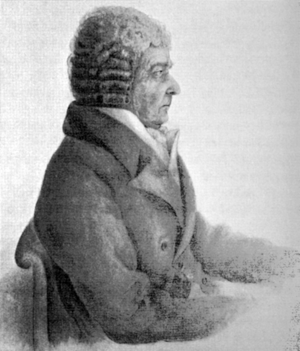John Latham (ornithologist) facts for kids
Quick facts for kids
John Latham
|
|
|---|---|
 |
|
| Born | 27 June 1740 Eltham, Kent, England
|
| Died | 4 February 1837 (aged 96) Winchester, Hampshire, England
|
| Nationality | English |
| Known for | A General Synopsis of Birds |
| Awards | FRS |
| Scientific career | |
| Fields | Ornithology |
| Author abbrev. (zoology) | Latham |
John Latham (born June 27, 1740 – died February 4, 1837) was an English doctor, a naturalist (someone who studies nature), and a writer. He is famous for his books about birds, especially A General Synopsis of Birds and General History of Birds.
Latham was one of the first people to study Australian birds. He saw many bird specimens that arrived in England in the late 1700s. He gave English names to many well-known Australian birds. These include the emu, sulphur-crested cockatoo, wedge-tailed eagle, and Australian magpie. He was also the first to describe the beautiful hyacinth macaw. Because of his important work, John Latham is often called the "grandfather" of Australian ornithology (the study of birds).
Contents
John Latham's Life Story
John Latham was born on June 27, 1740, in Eltham, which is in northwest Kent, England. His father, also named John Latham, was a surgeon. His mother came from the Sotheby family in Yorkshire.
Early Education and Medical Career
John Latham went to Merchant Taylors' School. After that, he studied anatomy (the study of the body's structure) with a famous teacher named William Hunter. He finished his medical training at hospitals in London.
In 1763, when he was 23, Latham started working as a doctor. He practiced medicine in the village of Darenth, near Dartford in Kent. In the same year, he married Ann Porter. They had four children together. Only two of their children, a son named John and a daughter named Ann, lived past childhood.
Later Life and Family
Latham stopped working as a doctor in 1796 when he was 56 years old. He moved to Romsey in Hampshire to live closer to his son. Sadly, his first wife, Ann, passed away in 1798. Later that same year, Latham married Ann Delamott.
His son, John, faced financial difficulties. He had invested in inns and ended up owing a lot of money. In 1817, his son was declared bankrupt. John Latham lost much of his own money trying to help his son. In 1819, Latham sold his house in Romsey. He and his wife then moved to Winchester to live with his daughter's family.
John Latham lived a long life. He died in Winchester on February 4, 1837, at the age of 96. He was buried in Romsey Abbey.
Latham's Work in Ornithology

John Latham's first major book about birds was A General Synopsis of Birds. This book included 106 drawings that Latham himself created. In it, he described many new bird species. He found these birds in different museums and collections.
Naming Birds: A Scientific Challenge
At first, Latham did not give scientific names to the species he described. He was like another naturalist, Georges-Louis Leclerc, Comte de Buffon, in this way. However, Latham soon realized that using the Linnean binomial system was important. This system gives each species a two-part scientific name (like Homo sapiens for humans). Using this system would ensure he received credit for discovering and describing new species.
So, in 1790, Latham published a book called Index Ornithologicus. In this book, he gave binomial names to all the species he had described earlier. But it was a bit too late! Another scientist, Johann Friedrich Gmelin, had already published his own version of Linnaeus's Systema Naturæ. Gmelin had given scientific names to many of Latham's species. Because of the rules of scientific naming, Gmelin's names were published first, so they had "priority."
Even so, Latham's 1790 book is still important. About eighty bird species are officially recognized with Latham as the person who first described them. These include the emu, the black swan, the hyacinth macaw, and the sulphur-crested cockatoo.
Later Publications and Discoveries
Latham published a supplement to his Index Ornithologicus in 1801. This book added even more scientific names. Most of the birds described in this supplement are found only in Australasia (Australia, New Zealand, and nearby islands). These include the Pacific gull, the barking owl, the noisy miner, and the Australian magpie.
Sometimes, Latham found it hard to tell different species apart, especially when working from drawings. He even described some birds more than once, giving them different names! For example, in his 1801 supplement, he described the Australian noisy miner four times. This caused some confusion for other bird scientists.
When Latham was in his eighties, he started publishing an even bigger version of his earlier work. This new set of books was called A General History of Birds and had eleven volumes. It was published starting in 1821.
Recognized for His Work
John Latham was a respected scientist. He regularly wrote letters to other important naturalists of his time, like Joseph Banks. In 1775, he was chosen to be a member of the famous Royal Society. He also helped create the Linnean Society, which is still very important for studying nature today. In 1812, he became a foreign member of the Royal Swedish Academy of Sciences.

